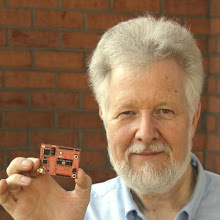There are some Programming Languages available named "visual", but not all are showing the same visual appearance. My look at a "visualFORTH" is a graphic one - the ability to select and arrange visual parts of the Module to be made in the realm of graphic, by clicking and moving parts and points onto and on the screen area provided for the final Module, doing it this way, the graphic way, instead of providing written text with numbers to set these parts onto selected places.
Both ways are visual, as everybody can see, but I am sure that public opinion will tell us working in the realm of graphics, or let's say drawings, instead of texts, is what is seen as visual.
It looks confusing, because both doings are visual - aren't they? I will tell you the real reason why it is called visual: it is the visual Part of the program which you will see on the screen when it is started. The written - and/or may bee graphically defined, also - functions behind the form you see are invisible, working under the surface.
All the effort is done to make work easier. The visual appearance of the Program shall be designed that it is easy to work with, psychologically correct, so to speak, and the kind of programming done to build the Program should be made as easy as possible, too.
That is the reason why there are more and more programming environments to make the drawing of the Form, the visual surface of the program, as easy as possible, using the visual, the graphic, the way of drawing with clicks and moves of points and parts, and to give functions to buttons - you name it - functions, which still have to have a written form, connected to the point of usage as nearly as possible. It should be clearly seen by the programmer, if he writes a function, it should be directly connected to the area, which is used to click upon to execute this function. This is kind of a must. The nearer, the better, and every time you check this designed area, this button, you should be able to check the function belonging to it, at least as long as the Form you are working on is under construction.
And making this part easy, the written instructions should as well be as easy to be done as possible. That's the reason why we use Forth as programming language. As you might know, Forth is the only programming language developed by a computer user, and is made to get the computer to work as easy as possible, with a minimum of effort, which results in high productivity.
Forth is an unusual computer language that has probably been applied to more varied projects than any other. It is the obvious choice when the project is exceptionally demanding in terms of completion schedule, speed of execution, compactness of code, or any combination of the above.
It has also been called “...one of the best-kept secrets in the computing world.”
This is no exaggeration: large corporations have purchased professional Forth development systems from vendors such as Laboratory Microsystems, Inc., Forth, Inc. or MicroProcessor Engineering, Ltd. and sworn them to secrecy. Some speculate (unkindly) that corporate giants prefer to hide their shame at using Forth; but I believe they are actually concealing a secret weapon from their rivals. Whenever Forth has competed directly with a more conventional language like C it has won hands down, producing smaller, faster, more reliable code in far less time. I have searched for examples with the opposite outcome but have been unable to find a single instance.
The above last two paragraphs are a quotation of Julian van Noble's (Professor Emeritus of Physics, University of Virginia) "Beginner's Guide to Forth".
Freitag, 29. Mai 2009
Abonnieren
Kommentare zum Post (Atom)

Keine Kommentare:
Kommentar veröffentlichen